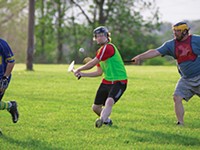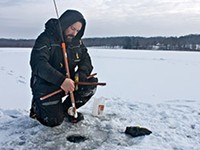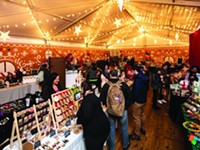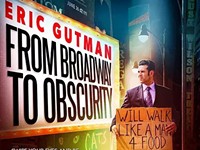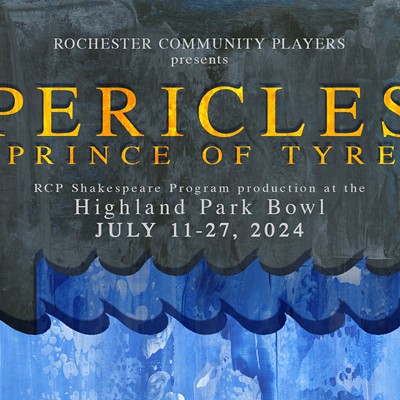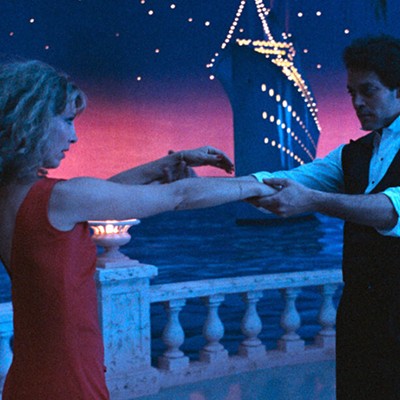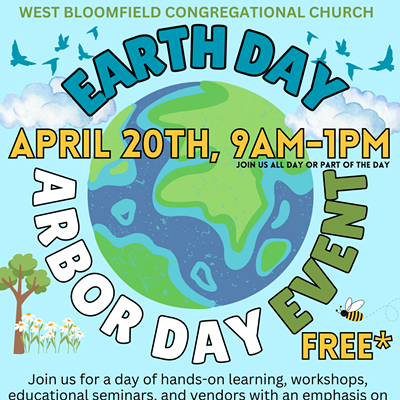[
{
"name": "500x250 Ad",
"insertPoint": "5",
"component": "15667920",
"parentWrapperClass": "",
"requiredCountToDisplay": "1"
}
]
"Striker to the line!" A well-dressed man in a suit, tie, and flat-brimmed black hat strides toward a small pile of dirt. Standing to one side of a whitish line of flour is a man wielding a hefty wooden bat. His worn, swollen fingers wrap slowly, but firmly, around the timber. He brushes a small tuft of graying hair behind his ear, and with a small grunt, he lifts the bat over his shoulder and stares down another man a short distance away. The pitcher winds up, his arm spins around like a windmill, and he lets loose a small yellow-tinted ball. The batter takes a swing.
There's no crack. The batter hasn't missed — the ball is simply too worn to make that distinct sound of connection. Instead, the ball has dropped right between the second basetender and the pitcher. It bounces off the hardened grass as the fielders scramble with bare hands to catch it. The batter sprints toward a small bag stuffed with hay at breakneck speed. His arms, covered in a full-length white button-up shirt, flap at his side. "Leg it!" his teammates cry from the sidelines. His foot lunges for the base, just as the ball comes flying toward the first baseman.
"Striker's dead!" the man in the suit shouts, and the batter turns and jogs glumly back toward his teammates, who aren't afraid to let him know what they think. "You've gotta stir your stumps on those ones, geezer!" says a man in dark green pants, white shirt, and suspenders, patting the batter on the back with a smirk. "Geezer" smirks back, as if he knew the Live Oak team would go on to beat the Victory Base Ball Club in their afternoon vintage base-ball game.
That's not a misspelling. Genesee Country Village & Museum in Mumford puts an old-timey spin on many familiar classics, including America's alleged favorite pastime: baseball. Every summer more than 100 volunteer players help bring the game back to its roots, complete with period uniforms, equipment, lingo, and rules. After more than a decade, the GCVM Vintage Base Ball program (yes, back in the day base ball was two words) has grown in size, popularity, and historical accuracy, giving fans the opportunity to learn more about a game they only thought they knew.
Baseball became known as America's pastime in the 19th century. Like our nation's founding fathers, the sport came to this country from overseas and has been adapted over the years. Baseball developed from various bat-and-ball games, including lapta (Russia), cricket and rounders (England), and schlagball (Germany). One of the first references to the name baseball came from the early 1800's in a town bylaw from Pittsfield, Massachusetts. The law banned strikers (baseball players) from playing too close to the new town hall (perhaps for fear of broken windows?). In the early half of the 19th century, small, friendly games started popping up at town halls and local parks. Despite overarching similarities, each area had its own set of rules for "town ball," "round ball," or what eventually became known as "base ball" (again, mind the gap between those two words).
There's a lively debate among vintage base ball enthusiasts about exactly when, where, and how the sport started. "We're really good from the mid-1850's on, but before that it's a little dicier," says Glenn Drinkwater, a local vintage base-ball player and source on the sport. "There's a lot of information out there."
Rochester holds a prominent place in the timeline of base ball, according to local base-ball history experts Joe Territo and Drinkwater. As players for the Rochester Base Ball Club team and Live Oak team respectively, the two have done extensive research into the founding of the sport. Territo also helped found the Rochester Baseball Historical Society, and Drinkwater previously served as president of the nationwide Vintage Base Ball Association.
Territo says base ball was described as being played in Rochester as early as 1825, which falls early on the historical timeline of the sport nationwide. Old newspaper articles and accounts describe a stick and ball game played on Mumford's meadow, a small pasture along the side of the Genesee River. "It's a very exciting thing for us base ball nerds," Territo says.
At least three clubs formed in Rochester in the mid- to late 1850's: The Rochester Base Ball Club, Live Oak, and Flour City. All three teams are now brought back to life every weekend during the summer on the Silver Base Ball Park field at Genesee Country Village & Museum. Territo, who spends his nights as a photographer for the modern Rochester Red Wings baseball team, says members of the historic Live Oak and Rochester base-ball clubs eventually went on to become early members of the Red Wings.
"Fans are usually surprised by some of the differences" of vintage base ball vs. modern baseball says Marty Brancato, a player for the Live Oak team at GCVM.
Among the most obvious departures from today's game is the fact that the players don't wear gloves. Luckily, they're not catching 90 mile-an-hour pitches out there. The pitchers, called hurlers or feeders back then, still pitch fast, but it's all done underhand. Strikers (batters) are also given a warning before an umpire doles out any strikes. Likewise, the hurler is warned if his pitches aren't up to par before the umpire calls a "ball."
But don't let those courtesies fool you. These players aren't afraid to tell one another when they're doing badly. It's commonplace to hear teams cry out when their players "muff" a play. The fans, or cranks, are encouraged to cheer using 19th century base-ball terms (for a full list of old school base ball terms, see the sidebar). You won't hear any food vendors shouting out, "Get your crackerjacks here!" since those weren't invented until 1893. But you can get your peanuts and hot dogs while watching the game.
At GCVM, the people behind the concession stand are also volunteers. The ladies in skirts who serve concessions at the men's games also hit the field on their own team. Although, some of the earliest recognized full-fledged ladies' teams didn't come along until the 1920's, Genesee Country Village Museum has two women's teams — The Brookes Grove Belles and Priscilla Porters' Ladies Base Ball Club — that also play games on weekends throughout the summer at the museum.
Because records were sparse and inconsistent, there is room for interpretation when it comes to the rules of the game. In fact, each season, the GCVM program's organizers decide which year of rules will govern play.
"Base ball has been evolving since it started," Territo says. "There was a lot of evolution during the 1800's. Every year, they'd come up with a different rule." This season, the players at GCVM are playing by 1866 rules — a crucial year in terms of the development of the sport.
That year, players were allowed to catch balls off of one bounce in foul territory and still have it count as an out. "That was more gentlemanly to catch the ball [on a bounce] than to catch it on the fly — with no gloves," says Brian Nagle, director of programs and collections for the museum. Nagle played behind (what modern baseball fans would call a catcher) and second base for the Live Oak team for a few years, but has since stopped playing to focus on his job at the museum. But prior to 1866, in what were called "bounder" games, batters would be considered out if a fielder caught the ball in fair territory even after one bounce.
"It's really important with all these crazy bounces and hops and things for the catcher to be quite agile in catching those for an out," Nagle says. "It's very frustrating for a batter to have that happen, but it's great as a catcher."
That said, vintage base ball fielders have to be wary of the way balls bounce on the field. The players must catch those balls bare-handed, and the old-fashioned style often means some old-fashioned injuries. Shake hands with some of these players and you can tell who's been playing longer. Their fingers are swollen and rough, some even have permanently deformed digits. I barely had time to ask Glenn "Geezer" Drinkwater if the 72-year-old had ever gotten hurt, when he proudly pushed his hand in my face, bent pinky finger and all.
"It's been like that for three or four years. I keep hoping one day I'll wake up and it'll be all better," he says.
Tony "The Tiger" Brancato was wearing a splint for the game I attended. "I broke that one," he says, pointing to his ring finger, "and that one," pointing to another. "And I broke my nose last year — It was a bad bounce," he says, adding a chuckle. "Most guys out here will break a finger, if you just catch one wrong."
A moment later, mid-sentence, Brancato turned to watch the striker — that's what they called batters back then — run toward first base, just as a fielder whipped the ball to the first baseman. "Striker's dead!" his brother and umpire for that game, Marty Brancato, yelled from the field. "You see there, he threw it to [the baseman] like a ballplayer who was wearing a glove," Brancato says. "Guys out here have been playing a long time, so you get used to catching it like that."
Territo has broken one finger and sprained another, a relatively low number among the players. "It's kind of a badge of honor for us vintage base-ball players; it's kind of like 'join the club,'" Territo says of injuries. Catching the ball with two hands in the "spring box" style, and cradling it slightly helped prevent players from injuring themselves.
"It makes us better base-ball players because it gives us what's known as having 'soft hands,'" Territo says. "Your throws have to be much more accurate because players are trying to catch with two hands. ... That limits your range of motion a bit; you can't reach too far from your body to catch a muffed throw." (Players would refer to a bad throw or play as "muffed." For a longer list of vintage base ball terms, see the sidebar).
There are plenty of other differences. Instead of a batter's box, there is a line drawn through the center of the home base that the striker (batter) must keep one foot on at all times. And the pitcher, called a hurler or feeder in those days, had a 3' to 4' area from which he had to throw. The hurler was expected to throw hittable balls, and in the same vein, the striker was intended to swing at the hittable balls. The umpire could warn either player if they were not up to snuff. "When it came down to it, the [striker] would say to the hurler, 'I want one right here,'" says Jim "Pops" Northup, a player for the Rochester Base Ball Club. "So as a pitcher, you were supposed to pitch it in there.'"
Vintage players use the same ball — just one — for the whole game. That means if the ball gets hit into the woods, everyone goes out looking for it. It also means that over the course of the game, the ball softens up from being hit over and over again. The ball itself is a piece of leather sewn around a rubber ball wrapped in yarn. Ball players in the 19th century would have used animal hide, but the Genesee Country Village Museum players decided to do away with that "ick" factor, mostly for sanitary reasons.
One thing most historians agree on is that vintage base ball was all about gentlemanly sportsmanship. Most players would cheer a good play from the opposing side as much as one from their own. Players were also penalized for cursing or for arguing with the umpire. Can you imagine if that were the case today?
Part of the aim of the Vintage Base Ball program at GCVM, Nagle says, is to make this a sport that the whole family can enjoy both on and off the field. "We really try to capture the historic accuracy of the game, with the rules, the uniforms, play and so forth," Nagle says.
Those uniforms include long pants, caps, and long-sleeve shirts made from mostly wool. That can prove a challenge to play in different weather conditions — and games are played in every kind of weather, unless there is lightning. The sun was beaming brightly during the first game I attended. The umpire went to the crowds in both stands, and asked if the ladies would be offended if the gentlemen — gasp! — rolled up their sleeves. Wearing a tank top on that 85-degree day, I found it pretty hard to object to that request. Still, every player on the Rochester team kept their sleeves down, choosing to stick to the traditional way of play.
"We try to maintain all of those 19th century expectations, and one of those expectations is that we need to be gentlemen," Territo says. "We're in public, and in the 19th century, you wanted to be respectable and respectful."
Base ball is a bit of a family tradition for the Brancato family. Marty Brancato, his brother Tony, and his nephew Brian Brancato all play for the Live Oak baseball team, and Brancato's 14-year-old nephew is waiting impatiently for his turn to join the team. All 90 or so players at the Genesee Country Village and Museum are volunteers, and range in age from 16 (the youngest they can start playing) to 72.
Marty Brancato, like many of the players, began with the team in its inaugural year in 2001. Brancato says he saw an ad in the newspaper, and convinced his brother-in-law to come to a meeting about the program with him. "We were sitting in the back row and once they started talking, we just looked at each other and started snickering like little kids in the candy store, like, 'This is so cool,'" he says.
By the second season, Marty's brother Tony caught the vintage base-ball fever. "I've been kicking myself every year for not doing it the first year. The following spring I was out here and I've been out here ever since," he says.
You could say baseball is in the Brancato's blood. "My grandfather played semi-pro and briefly professional base ball back in the day," Marty Brancato says. He says his grandfather returned to playing semi-pro ball to spend more time at home with his wife and two kids.
"My dad taught me how to play baseball, my grandfather taught me how to love baseball," says Marty Brancato. It's a similar sentiment shared by a handful of father-son pairs on each of the four teams that play at GCVM. Most grew up playing baseball or softball. "This family invents our own stupid, silly games," Marty Brancato says. "If there's a ball, a bat or stick, a way to make up rules, we're on it."
For Territo, vintage base ball was a way to combine his passion with his skills. "It was a cross between softball, which I was playing at the time, and baseball, which I loved," Territo says. "Like most kids that grew up in the 70's or any era before computers, baseball was part of an everyday thing in summertime. There wasn't a day that went by in the summer that I didn't go and play baseball with my friends."
The family-friendly vibe jives across team lines. "It really is its own little brotherhood of base ball,'" Territo says. "The camaraderie between our teammates is just fantastic. We are like a true 19th century base ball club when it comes to the socializing aspect of it. We're all friends — even across teams."
And those teams are growing each year. The museum now boasts four full men's teams and two ladies' base ball teams that play for about 14 weekends every summer. Nagle says the popularity of vintage base ball groups seems to have grown nationwide over the last five to 10 years.
"We're kind of spoiled here, because there are four teams, right here in one area. But then the next nearest team is going to end up somewhere in Pennsylvania or Ohio," Nagle says. Vintage teams from eight other areas come to the Genesee Country Village & Museum each year for the Silver Ball Tournament, which in 2012 was held the first week of August. (See sidebar for the mens' and womens' full schedules)
For the players, it's a time to socialize and embrace the fact that they get to play a game they've loved for years — even if the rules are a little different. "I'm a kid that never grew up," Northup says.
"Dirty Jim" Feuerstein says that makes for some high-scoring and exhilarating games. "Some of the best athletes you'll see out here are lifelong baseball or softball players," Feuerstein says. "You've got some very good athletes, and then you've got guys like me. And that works."
Nagle says it works for museum-goers too, and GCVM patrons have really latched onto this piece of Americana, helping the vintage base ball program grow over the past 12 seasons. "The early games were all played in a meadow or a grassy field with kids. It started as a social aspect, as a way of bringing communities together ... it's a sharing of values, it's a way to celebrate something." Nagle says. "It's something that truly is American."
For game schedules, admission rates, and more information on the Vintage Base Ball program at Genesee Country Village and Museum, visit gcv.org. For more about the history of baseball in Rochester, visit the Rochester Baseball Historical Society's Website, rochesterbaseballhistory.org.
Men's Schedule: All games played at Silver Base Ball Park at GVCM
Saturday, August 11, 1:30 p.m.: Sodus Point Exhibition
Saturday, August 18, 1:30 p.m.: Victory vs. Flower City
Sunday, August 19, 1:30 p.m.: Live Oak vs. Rochester
Saturday, August 25, 1:30 p.m.: Live Oak vs. Flower City
Sunday, August 26, 1:30 p.m.: Victory vs. Rochester
Saturday, September 8, Noon: Live Oak vs. Victory
Saturday, September 8, 2 p.m.: Flower City vs. Rochester
Saturday, September 15, Noon: Rochester vs. Live Oak
Saturday, September 15, 2 p.m.: Flower City vs. Victory
Saturday, September 22, 1:30 p.m.: Flower City vs. Rochester (playoffs)
Sunday, September 23, 1:30 p.m.: Live Oak vs. Victory (playoffs)
Saturday, September 29, 1:30 p.m.: Dummy Hoy Classic Game
Saturday, October 6, 1:30 p.m.: Mayor's Cup Consolation Game
Sunday, October 7, 1 p.m.: Mayor's Cup Championship
Women's Schedule
Saturday, August 18, Susan B. Anthony Square: Afternoon Public Match
Sunday, August 26, 1:30 p.m., Great Meadow: Porters vs. Belles
Sunday, September 9, 1:30 p.m., Silver Base Ball Park: Porters vs. Belles
Ace: Runs
Apple, pill, horsehide, onion: the baseball
Artist: exceptional player
Baller, Ballist: player
Basetender: infielder
Behind: the catcher
Bench: manager or coach
Blind: no score
Blooper, banjo hit: weak fly ball that barely goes beyond the infielders
Bowler, hurler, thrower, feeder: pitcher
Break one off: throw a curve ball (used in later years)
Bug bruiser: sharp grounder
Club Nine: the team
Cranks: Fans
Daisy Cutter: a well hit ground ball
Dew drop: slow pitch
Dead, Hand dead, Hand down: put out
Dish: home plate
Ducks on a Pond: bases loaded
Duff, Muff: error
Foul tick: foul ball
Four Baser: home run
Garden: outfield
Ginger: enthusiastic play
Ground: field
Hand out, hand down: player out
Hold Your First: stop running when you get to first base
Hold Your Second: stop running when you get to second base
Hold Your Third: stop running when you get to third base
Leg it: run hard, run faster
Make Your First: base hit, single
Make Your Second: double
Take Your Third: triple
Match: game
Midfielder: center fielder
Muckle: power hitter
Muffin: bad/worse player
The Line: batter's "box." It was actually just a line back in the early days
Pitcher's Point: pitcher's mound
Pluck: good strike, good play
Plugging the runner, soaking the runner: throwing the ball at the runner to put him out (this practice became illegal after 1845)
Rover: shortstop
Runner: One a striker (batter) is on base, they're called a "runner"
Scouts: outfielders
Show a little ginger: play harder, play smarter
Side out: three outs
Sky ball: pop fly, fly ball
Stringer: hard hit ball, oftentimes a home run
Stir your stumps: run faster, hustle
Striker: batter, hitter
Striker to the line: batter up
Tally: score, run count
Three hands out, three hands dead: three outs, teams switch, end of half of the inning
Whitewash: no-hitter inning, to hold a team scoreless in an inning
Willow: the bat
